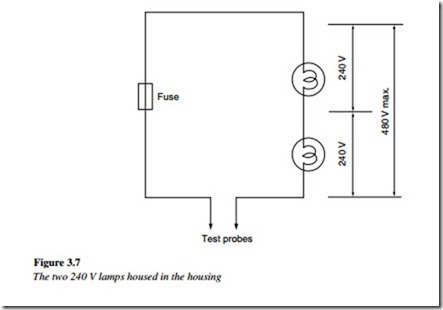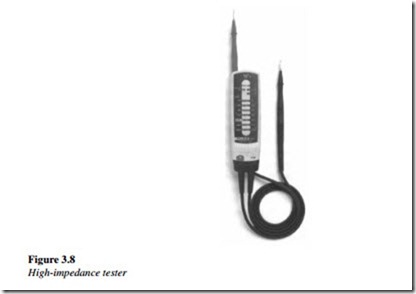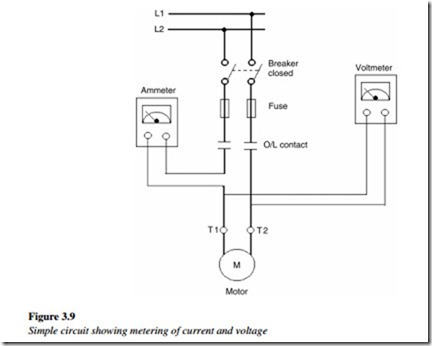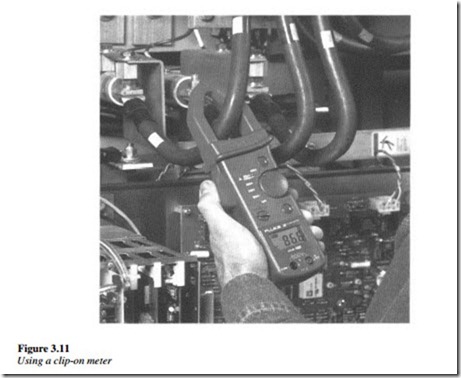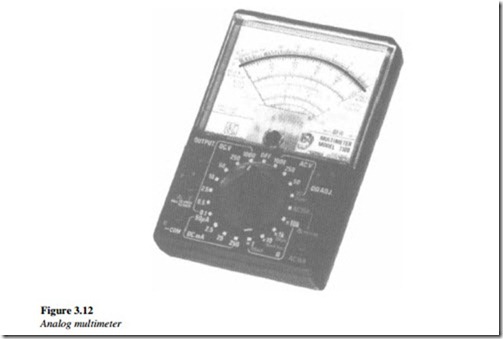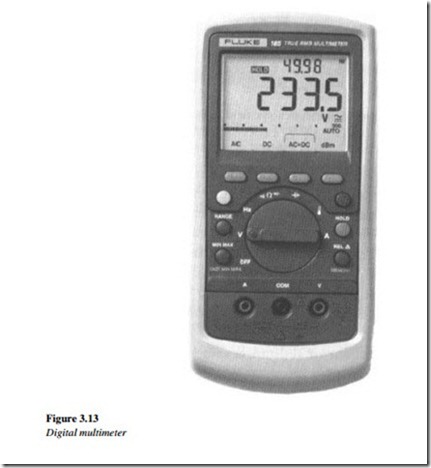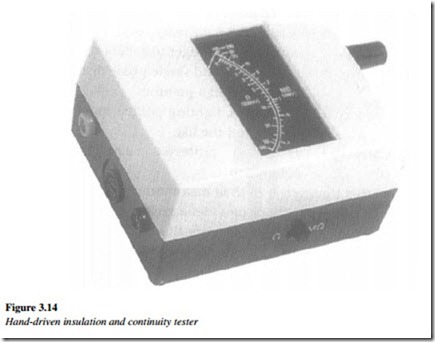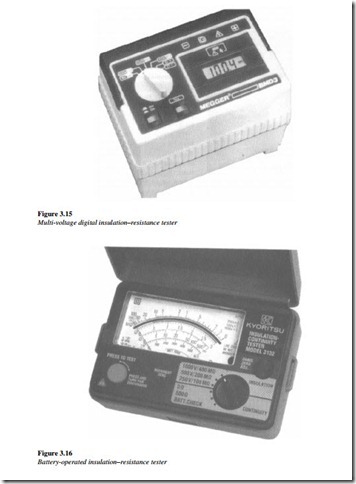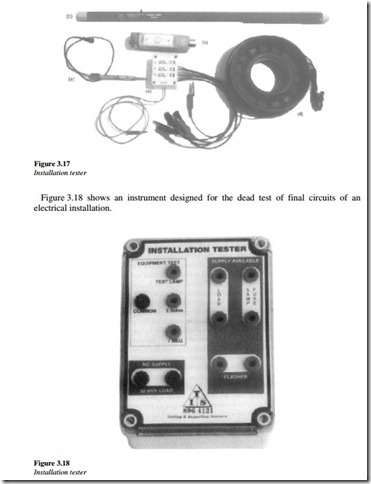Testing devices
To successfully troubleshoot in a short time, an understanding of the measurement meters that can be used and their various functions is mandatory. This is detailed in the following few sections.
Lamp indicators
A lamp indicator is the most basic tool used for troubleshooting by a practicing electrician. It is also known as a ‘Voltage Tester’. It consists of two 240 V lamps connected in series.
Description
As shown in Figure 3.7, both lamps are connected in series along with the fuse and probe that form a testing set. The low-wattage lamps comprise of equal power rating, not greater than 25 W per lamp. Use of two lamps is advisable as the tester may at times be subjected to line voltage (380/400/480) during testing. Single lamp if used may fail and erroneously indicate that the circuit is not live. As a precaution, all voltage testers should be checked before and after the test using a known live source.
For testing extra low voltages such as 12 or 32 V systems, one may use a single-lamp type.
Applications
Lamp indicator applications are listed below:
• For detecting the presence of a live potential
• For polarity of supply, i.e., the location of active points, neutral, and earth terminals or supply points
• For checking like or similar phases when ‘phasing out’ preparatory to paralleling two supplies
• Blown fuses
• Integrity of motor and three-phase supply system.
Testing of a motor
To check the earth condition, one lead of test lamps is connected to a live terminal of a single-phase supply and the second lead to a winding terminal. If the winding is earthed, the lamps will glow, else they will not glow.
Checking a three-phase supply voltage
To ensure there is no missing phase, connect both leads across the two phases. One of the following three instances will occur:
• If there is no supply then lamps will not glow
• If any one phase is missing then the lamps will glow at half brightness
• If both phases are connected then the lamps will glow at full brightness.
Present day voltage testers (duly approved types), when correctly handled, are safe live- testing devices due to their impedance and rating that a user cannot even mistakenly cause a short-circuit.
One such voltage tester available in the market is known as the ‘high-impedance tester’, as shown in Figure 3.8. This device gives an audible visual indication on detection of the presence of voltage.
A common handy device that is used by technicians for detection of voltage is the ‘Neon Tester’. This consists of a neon indicator with current-limiting resistor in series. When you put its conductive front portion over an active conductor, it will give an indication.
However, in most cases, this indication is faint and this confuses the user. In addition, it cannot be assumed that a lack of indication is the result of a lack of supply. In that case, a neon bulb may be inoperative.
A device used for the detection of electrical potential or for a polarity test is the ‘neon test pencil’. It is manufactured in a variety of types and designs. The intensity of glow will increase if a finger is placed on the cap or if the cap is earthed.
Therefore, it is advisable to use a good-quality neon tester from a safety and reliability point of view. It should be noted that the neon tester indicates the voltage of a conductor with reference to earth (because it has only one test lead and the circuit gets completed through the body of the person using it and earth). This test is sometimes not conclusive because an open circuit may exist in the neutral and remain undetected by this test. Also, neon testers sometimes give a glow at very low voltages and results are thus erratic. A proper voltage measurement using a voltmeter or multimeter is always more reliable and conclusive.
A comparison between analog and digital instruments is as follows:
• An analog meter shows reading by the movement of a pointer on a calibrated scale, whereas a digital meter shows a digital readout for the measurement directly.
• It is easier for a user to differentiate between readings in analog meters rather than in the digital one.
• In an analog meter, the reading is subjected to parallax error, while in a digital one there is no such possibility.
• For testing continuity, analog meters are a better choice.
For example, for an open-circuit full-scale deflection of the needle of an ohmmeter will show infinite reading. While for a closed circuit, it will show zero-resistance reading, thereby misleading the user.
Voltmeters and ammeters
For the measurement of voltage (potential difference) between two points, a device known as a voltmeter is used. This is a device used in live testing of a circuit.
Voltage measurement is conducted by connecting the voltmeter across the test points in a circuit.
A voltmeter can be used to measure AC/DC voltages of different ranges. Therefore, AC voltages should be measured by selecting AC and vice versa.
A voltmeter is always connected in parallel or shunt with respect to test points.
While operating a voltmeter, ensure that proper range of voltage is selected before conducting the measurement, because an instrument is designed for a particular range.
Failure to maintain the above-mentioned precautions results in safety hazards to both the user and the instrument.
When high-voltage measurements are required, then the measuring range of a voltmeter can be extended further by the addition of a voltage transformer (step down) with the meter.
Accordingly, the measurement scale requires a multiplication factor.
Currently, digital multimeters (DMM) with voltage measurement have auto range facility. This enables the instrument to automatically get the correct range in spite of the
user’s incorrect selection of range.
A voltmeter is used for the following purposes:
• Test continuity of power in a electrical circuit
• Check integrity of single-three-phase power
• Check integrity of devices such as relays and timers
• Check integrity of earthing.
An ammeter is the other device used to measure current flowing through closed low- voltage electrical circuits.
In addition, it is used in the live testing of an electrical circuit. Connecting the ammeter in series with the close electric circuit always does measurement of current. AC/DC currents of different (LV) ranges can be measured using an ammeter.
When connected in series with load (motor, fan), an ammeter will indicate the current consumed by the load. The current shown depends upon the exact connection of the ammeter.
In order to extend the range of measurement done by an ammeter, a CT is connected along with the meter. Accordingly, a multiplying factor will come into the picture.
Figure 3.9 shows the connection of an ammeter and voltmeter used for troubleshooting a motor starting circuit. As explained earlier, an ammeter is connected in series with the path, while a voltmeter is connected across the test points.
For very-high voltage circuits, it is unfeasible to disturb the circuit or take physical connection risks with the meters.
To avoid physical connection of an ammeter with the circuit, another handy device known as the clip-on meter is available in the market (Figure 3.10).
A clip-on meter, as the name suggests, is a handheld device that requires to be clamped with an active current carrying conductor in a circuit (Figure 3.11). The basic principle remains the same – a CT transfers high-rating current to a low-rating meter, which shows the reading on a calibrated scale.
This device works for AC/DC ranges with an option of various current ranges. It also has a hold facility, which helps in value storage after a reading is taken. Moreover, this device has the facility to be used as a voltmeter. It can be turned into a voltmeter by using the extra probes provided for testing. Therefore, it is a versatile measuring device. It can be used for rough and ready measurement of current flow in locations where individual phase leads are accessible. However, it cannot measure current in multi-core power
cables where all three-phase conductors run bundled into a single cable. When using a clip-on ammeter care should be taken to see that the CT clamp is fully closed without any air gap because the readings can be quire erroneous in the event of improper closing of the clamp.
Multimeters and ohmmeters
To perform various tests to check AC/DC voltage, current, resistance, frequency, continuity of circuit, or device integrity, the multimeter is a very useful device (Figure 3.12).
Various companies have different models with different functions. A multimeter consists of an ammeter, voltmeter, and an ohmmeter combined, with a function switch to connect the appropriate function.
The ohmmeter is essentially a current-measuring device. However, the scale is calibrated in ohms, enabling resistance values to be read directly.
This combination of volt–ohm–milliammeter is a basic tool for troubleshooting. The proper use of this instrument increases its accuracy and life. The following precautions should be observed during its usage:
1. To prevent meter overloading and possible damage when checking voltage or current, start with the highest range of the instrument and move down the range successively.
2. For higher accuracy, the range selected should be such that the deflection falls in the upper half of the meter scale.
3. Verify the circuit polarity before making a test, particularly when measuring
DC current or voltages.
4. When checking resistance in circuits, power supply to the circuit has to be switched off; otherwise, the voltage across the meter may damage the meter.
5. Renew multimeter batteries frequently to ensure accuracy of the resistance scale.
6. Recalibrate the instrument at frequent intervals.
7. Protect the instrument from dust, moisture, fumes, and heat.
Digital multimeter
The features of a multimeter (Figure 3.13) are listed as follows:
• Functionally easy
• Directly indicates the numeric value of measurement on an LCD display
• Measurement-variable – voltage, current, resistance can be selected using the function button
• Auto range feature provides automatic adjustment of internal circuits to appropriate current, voltage, or resistance
• Hold feature allows storage of reading of quantity measurement in memory for future viewing
• Auto polarity feature automatically displays + or – sign on display to indicate polarity of DC measurements
• Some meters also provide Min/Max value indication for measurement
• Peak hold feature holds the peak value of measured quantity
• Quick check features such as diode test, transistor test, capacitor test, etc. are also available.
Operating DMM
To operate the DMM, please perform the following steps:
• Before connecting the test probe that leads to the circuit, ensure proper function has been selected as per measured quantity.
• Check the correct insertion of test probes in proper plugs – this will avoid possible damage to the multimeter due to an incorrect function selection or an incorrect probe insertion.
• If the multimeter does not have an auto range feature then check for the range selector switch position – now, the variable can be measured.
If the measuring position/location is awkward, data can be stored using the hold function for later viewing. The data can be viewed even after the probes are disconnected from the circuit.
CRO (cathode ray oscilloscope)
The CRO measuring instrument may sound very familiar, as it is a very useful device. It is used for measurement of voltages (AC/DC) and display of waveforms by providing information on time duration, frequency, and their shapes.
In the following section, we will discuss the features and mode of operation of the CRO.
Features of CRO
Below are listed the various features of the CRO:
• It allows voltage (AC/DC) amplitude measurement and time period measurement from the waveform displayed on screen.
• Dual trace CRO allows the user to see two traces at a time on two different channels for comparison.
• Two sets of controls provide the facility to show time period differences, amplitude differences, and shape/distortion comparison.
• Storage oscilloscopes allow storage of waveforms for later analysis.
• Storage facility is very useful since it provides a cursor function, which shows the value of a measured variable at a particular instance.
Operating CRO
To operate the CRO, perform the following procedure:
• The power on switch is provided for on/off control.
• The measurement probe provided consists of two leads – one connected to the signal and the other, ground probe, connected to the ground of circuit.
• Turn on the CRO.
• Check the integrity of leads and the CRO by connecting the I/P probe to a test socket of 5 V square wave signal.
• While checking non-isolated signals (that are earthed) do not connect ground/earth to the CRO, else it may create a short-circuit at the input signal.
• Adjust both channels’ vertical axis by placing AC\DC\GND signal in GND position.
• Place the function switch in the suitable signal function as required (AC\DC).
• Check the test probe selection, i.e., divide by 1 or 10 that allows signal attenuation.
• The intensity knob is used to vary the brightness of the trace.
• The focus knob is used to change the sharpness of the trace displayed.
• The Y shift allows you to shift the waveform displayed vertically (up/down).
• The X shift allows you to shift the waveform displayed horizontally left or right.
• The Volts/Div switch is used to vary the magnitude of the voltage variable displayed on the screen. It is calibrated in Volts/Div of the vertical scale. A control knob is provided in the center to adjust amplitude between calibrated settings.
• To find the amplitude of a signal multiply the Y-axis reading with the Volts/Div setting.
• The Time/Div is used to control the span of the X-axis.
• Physical markings between two points can be used to calculate the time span. The same time span can be used to measure the frequency of the waveform displayed.
• A control knob is provided at the center for the same purpose as in Volts/Div.
• To find the time duration of a waveform, measure the signal span reading difference. When this is multiplied by Times/Div it will give the time duration of the signal.
Safety standards for measuring instruments
While a person is conducting tests with an instrument on live line supply, there is a possibility of a sharp rise in voltage for a short duration. This may result in an arc or flash between measurement terminals of the testing device. In addition, if a heavy flash occurs, it may critically injure a person handling the instrument.
To safeguard the person using the measuring instrument and to classify the various instruments as per the application they are used in, the IEC has classified instruments in the following categories:
• Category IV: Distribution systems, service connections, and primary over- current protection for larger installations
• Category III: Three-phase and single-phase distribution within a premises
• Category II: Appliances, lighting points, socket-outlets
• Category I: Transient-protected electronic equipment.
The IEC Standard 61010 provides guidelines for manufacturers to follow safety norms for testing devices. It is to be noted that irrespective of their maximum voltage rating, a Category IV device provides a greater degree of transient protection than Category III, etc. The Category III device is suitable for most of the testing undertaken by electricians.
Insulation-resistance testers or meggers
Another common method of measuring resistances ranging 0–1000 MΩ is by using meggers or insulation-resistance testers. This is the usual ohmmeter with a battery used for voltage source.
This instrument is used to measure very high resistances, such as those found in cable insulations, between motor windings, in transformer windings, etc.
Normal multimeters do not provide accurate indications above 10 MΩ because of the low voltage used in the ohmmeter circuit. Meggers can apply a high voltage to a circuit under test and this voltage causes a current if any electrical leakage exists. This makes it useful as an insulation tester.
Some laboratory test meters have a built-in high-voltage source. The high voltage permits accurate high-resistance measurement, but such meters are usually not portable.
The megger is essentially a portable ohmmeter with a built-in high-voltage source. The built-in high-voltage source may be derived from a magnet-type DC generator or battery.
In a DC generator-type megger, a hand crank is used to turn the armature to produce voltages up to 500, 1000, and 2500 (depending on the model used).
An electronic battery-operated type of instrument is popular because it is light, compact, and can be held and operated in one hand, i.e., there is no generator to turn. High-testing voltage is produced by an electronic circuit, which uses an internal battery as an energy source. The instrument in Figure 3.13 has a range of 0–100 MΩ and infinity at a testing voltage of 500 V. It has the same voltage-measuring facility as the hand-driven insulation tester.
Resistance is directly displayed on the front panel digital display. A range of voltages can be selected while testing.
Testing accessories
Depending upon specific applications, special testing devices are used specifically to improve the accuracy and efficiency of testing an installation. Some of these devices are shown in the figures given here. Figure 3.14 shows a hand operated insulation tester (commonly called as Meg. Ohm Meter or ‘Megger’).
Figure 3.15 shows an electronic version of such a device, a multi-voltage digital insulation tester with the test voltage being generated from a battery source. Figure 3.16 shows an analog bersion of a similar instrument.
Figure 3.17 shows various accessories forming part of the testing instruments. These instruments help electrical installation contractors to test their installation in order to ensure that the installation is safe to connect to the supply.
These devices are intended to help improve the safety and efficiency with which tests are carried out. The testing principles remain the same and these must be understood before the benefits of using such devices can be fully realized.
